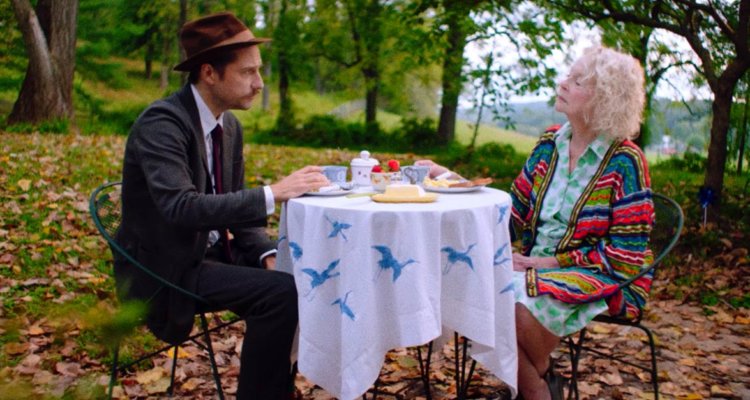No space is safe from the evils of monetization, insidiously prevalent marketing, advertising, and the propaganda of suggestive consumption. And in “Strawberry Mansion,” a surreal, idiosyncratic, feature-length film co-directed by Albert Birney and actor/filmmaker Kentucker Audley, the cynical, dystopian perspective says even your headspace will soon become fair game—not only for the government trying to squeeze an extra dollar out of your thinning wallet, but for those looking to exploit your dreams. Bernie and Warren on low-dose edibles, might really dig it.
READ MORE: 25 Most Anticipated 2021 Sundance Film Festival Premieres
Their candy-color-coated film, “Strawberry Mansion,” is ridiculous and whimsical, with the cruddy analog, lo-fi aesthetics of a cult weirdo classic in the making, but also jam-packed with a lot of heady ideas about capitalism, exploitation, invasive surveillance statehood, and the encroaching colonization of the mind with subconscious commercials. It’s also a strange, ambitious, but microbudgeted cosmic journey into dreams swirled together with Marshall McLuhan, George Orwell, Marx, Kafka, and a metaphysical love story to boot.
READ MORE: The 100 Most Anticipated Films Of 2021
Set in the not-too-distant future, Kentucker Audley performs double duty, starring as an unassuming government agent James Preble, a dream auditor, traveling from town to town to review and inspect the unconscious mind for what it owes the state.
READ MORE: ‘How It Ends’: The Film You Worried Covid Might Produce Is Here [Sundance Review]
Preble’s undertaking becomes extremely challenging when he’s sent to audit the dreams of Arabella “Bella” Isadora (Penny Fuller), an eccentric, aging artist, living in a remote farmhouse off the grid. Unlike those complying with the rules of modern technology, all her dreams are recorded and filed away on old, scratchy VHS tapes—a DIY vintage and stylish aesthetic scotch-taped together with the glitchy digital mien.
READ MORE: Cynthia Erivo Among 2021 Sundance Film Festival Jurors
Yet, the dutiful Preble rolls up his sleeves and gets to work, reluctantly staying at Bella’s home and being taken aback by her intrusive curiosity into his private work. Insider her dreams, however, the already unusual presentation of this crude, low fidelity dystopian world becomes even more bizarre. Preble gets swept up in the life, dreams, and experiences of a young and beautiful Bella (Grace Glowicki), but as things are wont to do in this kind of hypnagogic setting, reality and chimerical dreams and visions begin to blur and distort into unsettling hallucinations and fantasies.
While he works and confusion sets in, the older Bella starts to educate Preble about the tricks and tools needed to circumvent and thwart the secret world of sinister marketing embedded within the dreamspace. At first, he takes these tinfoil hat ideas as the ramblings of a peculiar and delusional old woman, but when they work, he realizes a greater conspiracy is afoot.
When the collusion threatens to be exposed, Bella’s older son (Reed Birney) arrives on the scene and Preble escapes to the dream world with younger Bella, eventually trapped and trying to find their way back home.
Like a trippy lollipop of color, animal costumes, and hodgepodge scratchy, squelchy analog inputs and gluey visuals, “Strawberry Mansion” is unpolished, tactile, and quirky. Much of its aesthetics and VFX are throwback, and old school; something like a cross between using an outmoded Amiga 2000 digital toaster effects from the ‘90s and plugging into a space-age ‘70s synthesizer and achieving vibrating sounds that are out of this world, but impossible to replicate twice. Appropriately positioned into the NEXT section at Sundance, “Strawberry Mansion,” would fit in nicely on the Z Channel at 3 am or an offbeat film festival of basement tape oddities (Guy Maddin feels like maybe a spiritual cousin of sorts, minus the saturation)
This is pretty much the raison d’etre of Birney’s work, and the collaboration so far between Birney and Audley an unconventional wavelength that rubber cements together the absurd and the poignant (see their similar strange mashup “Silvio” about a small-town gorilla, his mishaps on a local TV station and his journey of self-discovery).
Featuring a trippy, gauzy score by Dan Deacon, for all of its cultural relevancy and political texture about capitalistic systems looking to exploit the working man, the film’s whimsy and low-key absurdist charms are easily its best features. That said, its interdimensional/intergenerational love story is affecting too, the usually-wryly-comedic Audley convincing at creating a character that suffers from an acute loneliness in life everyone can truly relate to in the age of quarantine. Beneath the layers of fuzzy frequencies, feverish absurdism, and kaleidoscopic tints lives an inconspicuously poignant movie about existentialist dread, the very human need to reduce the noise, and the genuine longing for connection in a chaotic, jumbled up world. [B+]
Follow along with all of our coverage of this year’s Sundance Film Festival here.

